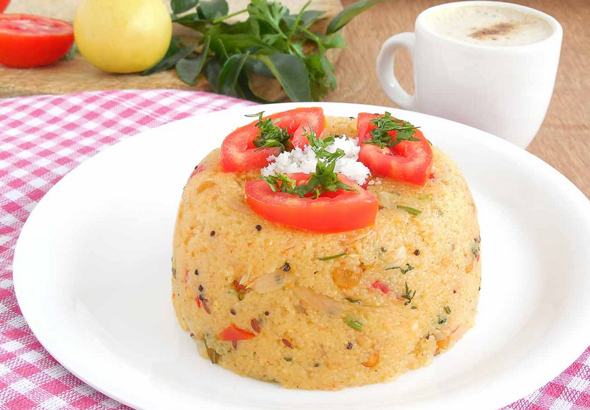Mama’s Punjabi Recipes: Upma (Spicy Sauteed Semolina)
Saved under Community, Current Stories, Recipe Corner
Tags: Baytown, Clear Lake, Cypress, Desi news, Greater Houston, Houston, Houston Desi news, India, Indian American community, Indian News, Indians in America, Indo-American News, Katy, Mama’s Punjabi Recipes, NRI, pearland, Shakuntla Malhotra, south asia, South India, Sugar Land, Texas, Upma, USA
With the passage of time, some South Indian dishes have become immensely popular in North India and among Punjabis to the point that they have become commonplace in many homes. Among the most popular are dosas (stuffed, rolled rice waffles), idlis (steamed rice flour buns) served with sambar (a lentil-based vegetable stew) and upma (spicy sautéed semolina).
Many Punjabi households know how to make these southern dishes and most eat them on weekends as a special breakfast or lunch treat. There are countless dosa shops in New Delhi and many other cities and towns all over the northwest part of the country. And upma has become a popular breakfast item due to its simplicity, quick cooking time and spicy taste.
Upma is a thick porridge-like dish most common in South Indian, Maharashtrian and Sri Lankan Tamil breakfast made of coarse sooji (semolina) to which various vegetables, seasonings and spices are added. In the South, it is called uppindi, uppumavu or uppittu from the words uppu meaning salt and pindi, mavu or hittu meaning flour, but in the North it is simply upma.
Sooji upma, also called rava upma in Karnataka, Maharastra, Tamil Nadu and parts of Andhra Pradesh, is high in carbohydrates, potassium and sodium. Upma can also be made of coarse whole wheat (very popular in Tamil Nadu and in Coimbatore), coarse rice flour (popular in Tamil Nadu and southern parts of Karnataka). corn flour or even vermicelli which is served as a light evening snack.
Ingredients:
• 1 cup sooji (semolina) – medium coarse
• 2 or 3 cups pani (water)
• 3 tbsp tael (olive oil or vegetable oil)
• 1 small pyaaz (onion) – chopped
• Green Seasonings: karri patta (curry leaves); hari mirch (green chillies); adrak (ginger)
• Seasonings 1 tsp each: channa dal; urad dal; sarson til (mustard seeds)
• Spices to taste: haldi (turmeric), dhania (chopped coriander leaves), lal mirch (red pepper), namak (salt)
Directions:
1. Heat the sooji in a kadai or wok and roast till it is lightly brown. Do not add oil. Take out and place to the side.
2. Finely chop the onions and the green seasonings.
3. Heat the oil in the same kadai or wok over medium heat.
4. Add in all the green seasonings and onions and stir till they are brown and the onions caramelized.
5. Add ½ cup of water and throw in the remaining seasonings and the spices. Stir the mixture and let it come to a boil for 1 minute.
6. Now add in the roasted sooji, and stir over medium heat.
7. After 5 minutes, turn off the heat and cover the kadai to let the sooji fluff up and the seasonings and spices seep in.
8. Before serving, sprinkle with the dhania and squeeze some lemon juice over the top of the dish.
9. Serve hot with some pickles or dahin (yogurt). When it cools down, the sooji will swell up and can be thinned down by reheating and adding some warm water.
MAMA’S TIP OF THE WEEK: CLEAN CALCIUM DEPOSITS IN COFFEE PERCOLATOR WITH WHITE VINEGAR
If you love coffee and prefer to use a percolator, you probably know that after a while there is a white film that starts to coat the inside of the water chamber and also on the bottom of the glass kettle. This usually leads to longer times for the coffee to be made as the calcium constricts the water flow and insulates the bottom of the glass jar so it doesn’t keep the coffee as warm.
This white film is the calcium and magnesium deposits from the water after it has been heated and is very common where the water is hard. To remove it, pour one full glass of common white vinegar into the percolator and turn it on. Collect the spent vinegar in the bowl after it has run through the system, and use it to repeat the step another two times. The calcium deposits will settle to the bottom of the bowl and can be drained off. Later, run a clean bowl of water through the percolator three times to get rid of the vinegar taste.

Shakuntla Malhotra is a skilled cook of Punjabi dishes made in the old-fashioned style that she learnt as a young woman in her ancestral home in Lyallpur (since renamed Faisalabad), India before it became part of Pakistan after the Partition in 1947. People have often admired her cooking for its simplicity and taste that comes with each mouthful. Even in her mid-eighties, she continues to cook daily and agreed to share some of her delectable Punjabi recipes

